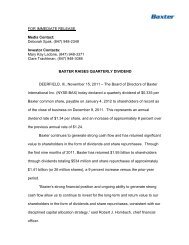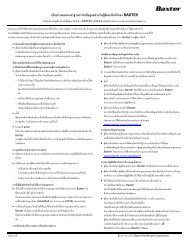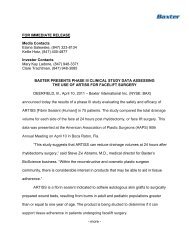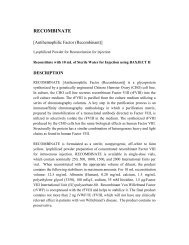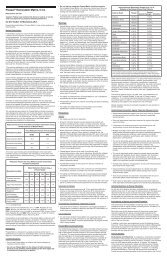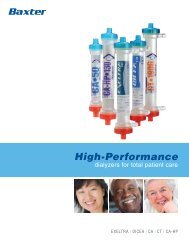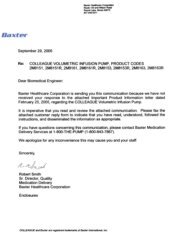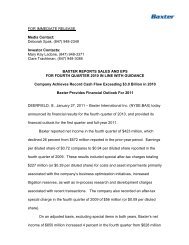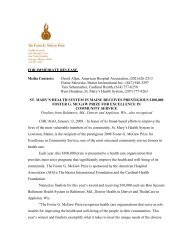EXTRANEAL (icodextrin) Peritoneal Dialysis Solution - Baxter
EXTRANEAL (icodextrin) Peritoneal Dialysis Solution - Baxter
EXTRANEAL (icodextrin) Peritoneal Dialysis Solution - Baxter
You also want an ePaper? Increase the reach of your titles
YUMPU automatically turns print PDFs into web optimized ePapers that Google loves.
Heparin<br />
No human drug interaction studies with heparin were conducted. In vitro studies<br />
demonstrated no evidence of incompatibility of heparin with <strong>EXTRANEAL</strong>.<br />
Antibiotics<br />
No human drug interaction studies with antibiotics were conducted. In vitro<br />
studies evaluating the minimum inhibitory concentration (MIC) of vancomycin,<br />
cefazolin, ampicillin, ampicillin/flucoxacillin, ceftazidime, gentamicin, and<br />
amphotericin demonstrated no evidence of incompatibility of these antibiotics<br />
with <strong>EXTRANEAL</strong>. (See DOSAGE AND ADMINISTRATION)<br />
Drug/Laboratory Test Interactions<br />
Blood Glucose<br />
Blood glucose measurement must be done with a glucose-specific method to<br />
prevent maltose interference with test results. Falsely elevated glucose levels<br />
have been observed with blood glucose monitoring devices and test strips that<br />
use glucose dehydrogenase pyrroloquinolinequinone (GDH-PQQ), glucosedye-oxidoreductase<br />
(GDO), and some glucose dehydrogenase flavin-adenine<br />
nucleotide (GDH-FAD)-based methods. GDH-PQQ,glucose-dye-oxidoreductase,<br />
and some GDH-FAD-based methods must not be used to measure glucose levels<br />
in patients administered <strong>EXTRANEAL</strong>. (See WARNINGS).<br />
Serum Amylase<br />
An apparent decrease in serum amylase activity has been observed in patients<br />
administered <strong>EXTRANEAL</strong>. Preliminary investigations indicate that <strong>icodextrin</strong><br />
and its metabolites interfere with enzymatic-based amylase assays, resulting<br />
in inaccurately low values. This should be taken into account when evaluating<br />
serum amylase levels for diagnosis or monitoring of pancreatitis in patients using<br />
<strong>EXTRANEAL</strong>.<br />
Carcinogenesis, Mutagenesis, Impairment of Fertility<br />
Icodextrin did not demonstrate evidence of genotoxicity potential in in vitro<br />
bacterial cell reverse mutation assay (Ames test); in vitro mammalian cell<br />
chromosomal aberration assay (CHO cell assay); and in the in vivo micronucleus<br />
assay in rats. Long-term animal studies to evaluate the carcinogenic potential of<br />
<strong>EXTRANEAL</strong> or <strong>icodextrin</strong> have not been conducted. Icodextrin is derived from<br />
maltodextrin, a common food ingredient.<br />
A fertility study in rats where males and females were treated for four and two<br />
weeks, respectively, prior to mating and until day 17 of gestation at up to 1.5<br />
g/kg/day (1/3 the human exposure on a mg/m 2 basis) revealed slightly low<br />
epididymal weights in parental males in the high dose group as compared to<br />
Control. Toxicological significance of this finding was not evident as no other<br />
reproductive organs were affected and all males were of proven fertility. The study<br />
demonstrated no effects of treatment with <strong>icodextrin</strong> on mating performance,<br />
fertility, litter response, embryo-fetal survival, or fetal growth and development.<br />
Pregnancy<br />
Pregnancy Category C<br />
Complete animal reproduction studies including in utero embryofetal development<br />
at appreciable multiples of human exposure have not been conducted with<br />
<strong>EXTRANEAL</strong> or <strong>icodextrin</strong>. Thus it is not known whether <strong>icodextrin</strong> or <strong>EXTRANEAL</strong><br />
solution can cause fetal harm when administered to a pregnant woman or affect<br />
reproductive capacity. <strong>EXTRANEAL</strong> should only be utilized in pregnant women<br />
when the need outweighs the potential risks.<br />
Nursing Mothers<br />
It is not known whether <strong>icodextrin</strong> or its metabolites are excreted in human milk.<br />
Because many drugs are excreted in human milk, caution should be exercised<br />
when <strong>EXTRANEAL</strong> is administered to a nursing woman.<br />
Pediatric Use<br />
Safety and effectiveness in pediatric patients have not been established.<br />
Geriatric Use<br />
No formal studies were specifically carried out in the geriatric population.<br />
However, 140 of the patients in clinical studies of <strong>EXTRANEAL</strong> were age 65 or<br />
older, with 28 of the patients age 75 or older. No overall differences in safety or<br />
effectiveness were observed between these patients and patients under age 65.<br />
Although clinical experience has not identified differences in responses between<br />
the elderly and younger patients, greater sensitivity of some older individuals<br />
cannot be ruled out.<br />
-4-<br />
07-19-65-351<br />
ADVERSE REACTIONS<br />
Clinical Trials<br />
Because clinical trials are conducted under widely varying conditions, adverse<br />
reaction rates observed in clinical trials of a drug cannot be compared to rates<br />
in the clinical trials of another drug and may not reflect the rates observed in<br />
practice. The adverse reaction information from clinical trials does, however,<br />
provide a basis for identifying the adverse events that appear to be related to drug<br />
use and for approximating rates.<br />
<strong>EXTRANEAL</strong> was originally studied in controlled clinical trials of 493 patients with<br />
end-stage renal disease who received a single daily exchange of <strong>EXTRANEAL</strong> for<br />
the long dwell (8-to 16- hours). There were 215 patients exposed for at least 6<br />
months and 155 patients exposed for at least one year. The population was 18-83<br />
years of age, 56% male and 44% female, 73% Caucasian, 18% Black, 4% Asian,<br />
3% Hispanic, and it included patients with the following comorbid conditions:<br />
27% diabetes, 49% hypertension and 23% hypertensive nephropathy.<br />
Rash was the most frequently occurring <strong>EXTRANEAL</strong>-related adverse event<br />
(5.5%, <strong>EXTRANEAL</strong>; 1.7% Control). Seven patients on <strong>EXTRANEAL</strong> discontinued<br />
treatment due to rash, and one patient on <strong>EXTRANEAL</strong> discontinued due to<br />
exfoliative dermatitis. The rash typically appeared within the first three weeks of<br />
treatment and resolved with treatment discontinuation or, in some patients, with<br />
continued treatment.<br />
Female patients reported a higher incidence of skin events, including rash, in both<br />
<strong>EXTRANEAL</strong> and dextrose control treatment groups.<br />
Table 1 shows the adverse events reported in these clinical studies, regardless of<br />
causality, occurring in ≥ 5% of patients and more common on <strong>EXTRANEAL</strong> than<br />
control.<br />
Adverse reactions reported with an incidence of > 5% and at least as common on<br />
dextrose control included pain, asthenia, exit site infection, infection, back pain,<br />
hypotension, diarrhea, vomiting, nausea/vomiting, anemia, peripheral edema,<br />
hypokalemia, hyperphosphatemia, hypoproteinemia, hypervolemia, arthralgia,<br />
dizziness, dyspnea, skin disorder, pruritis.<br />
Additional adverse events occurring at an incidence of < 5% and that may or<br />
may not have been related to <strong>EXTRANEAL</strong> include: pain on infusion, abdominal<br />
enlargement, cloudy effluent, ultrafiltration decrease, postural hypotension, heart<br />
failure, hyponatremia, hypochloremia, hypercalcemia, hypoglycemia, alkaline<br />
phosphatase increase, SGPT increase, SGOT increase, cramping, confusion,<br />
lung edema, facial edema, exfoliative dermatitis, eczema, vesicobullous rash,<br />
maculopapular rash, erythema multiforme. All reported events are included in the<br />
list except those already listed in Table 1 or the following two paragraphs, those<br />
not plausibly associated with <strong>EXTRANEAL</strong>, and those that were associated with<br />
the condition being treated or related to the dialysis procedure.<br />
<strong>EXTRANEAL</strong> was additionally studied in a subpopulation of 92 high average/high<br />
transporter APD patients in a two-week controlled clinical trial where patients<br />
received a single daily exchange of <strong>EXTRANEAL</strong> (n=47) or dextrose control (n=45)<br />
for the long dwell (14 ± 2 hours). Consistent with the data reported in the original<br />
trials of <strong>EXTRANEAL</strong>, rash was the most frequently occurring event.



